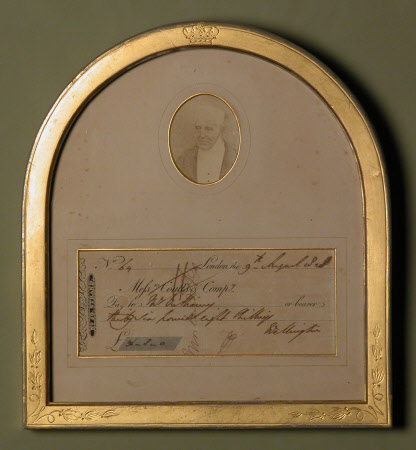Cheque signed by and portrait of Arthur Wellesley, 1st Duke of Wellington, KG, KB, MP (1769-1852)
Coutts and Co
Category
Manuscripts and documents
Date
1828
Materials
Paper
Measurements
21 x 18 in
Place of origin
Strand
Order this imageCollection
Hughenden, Buckinghamshire
NT 428467
Summary
Cheque signed by the Duke of Wellington, dated 9 August 1828, drawn on Messrs. Coutts and Co, for £36.8.0. Cheque and an oval portrait bust of the Duke are set in a mount with gilt edging, within a gilt arched frame. Top of frame etched with a coronet, bottom corners with floral design.
Provenance
Statement from Professor Chris, University of Southampton:The cheque is made out to ‘Mr Vulliamy’; it is a crossed cheque (the two vertical lines – you will still find these printed on cheques today) which means it must be paid into a bank account, and is not for cash; what is written at right angles to the text shows that it has been paid into a bank account – what it says is ‘Morland and Co.’ – this is the payee’s bank. They had premises in Pall Mall. Once a cheque has been presented for payment, in this case Coutts will have paid the other bank; the cheque will then have been returned by Coutts to the Duke of Wellington – and it is likely that this came from his paperwork when it was being scaled down later in the nineteenth century. Returning cheques to account holders was the normal practice. Vulliamy is a renowned London clockmaker – Benjamin Lewis Vulliamy – so why was Wellington in contact with him? In 1828 the Duke was Prime Minister, but that’s really a red herring here (although it may have been important to Disraeli in buying this item); what Wellington was doing at this point is refurbishing his London house, Apsley House, in Piccadilly – after Waterloo he was voted funds by the nation, and rather than buying an estate and building a palace (as Marlborough did at Blenheim), he bought a more modest country property, Stratfield Saye House, in Hampshire, near Reading; and he remodelled Apsley House in the 1820s (which he had bought from his brother, Richard, Marquess Wellesley), creating the Waterloo Gallery. The works on this are very much under way in the 1820s and I think it probable that a Vulliamy clock was bought as part of this – it could, however, have been bought for Stratfield Saye,.There is a Vulliamy wall clock in the Royal Collection – bought by George IV in the late 1820s also (https://www.rct.uk/collection/30065/wall-clock) – and you will find them in other collections too. Vulliamy was designated ‘clockmaker to the king’, and he was also engaged on public clocks for government buildings (I think the Horse Guards, maybe wrong), and elsewhere. But what the Duke may have bought could have been a rather different sort of product, a case or mantlepiece clock.
Makers and roles
Coutts and Co, banker
